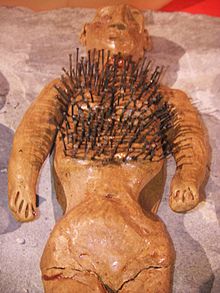
The term voodoo doll commonly refers to an effigy that is typically used for the insertion of pins. Such practices are found in various forms in the magical traditions of many cultures around the world.
Despite its name, the voodoo doll is not prominent in the African diaspora religions of Haitian Vodou nor Louisiana Voodoo. Members of the High Priesthood of Louisiana Voodoo have denounced the use of voodoo dolls as irrelevant to the religion.
Depictions in culture
20th-century link with Voodoo

The association of the voodoo doll and the religion of Voodoo was established through the presentation of the latter in Western popular culture during the first half of the 20th century as part of the broader negative depictions of Black and Afro-Caribbean religious practices in the United States. In John Houston Craige's 1933 book Black Bagdad: The Arabian Nights Adventures of a Marine Captain in Haiti, a Haitian prisoner is described sticking pins into an effigy to induce illness. In film, representations of Haitian Vodou in works such as Victor Halperin's 1932 White Zombie and Jacques Tourneur’s 1943 I Walked with a Zombie also involves the use of the dolls. Voodoo dolls are also featured in one episode of The Woody Woodpecker Show (1961), as well as in the British musical Lisztomania (1975) and the films Creepshow (1982), Indiana Jones and the Temple of Doom (1984), The Witches of Eastwick (1987) Child's Play (1988) and Scooby-Doo on Zombie Island (1998).
By the early 21st century, the image of the voodoo doll had become particularly pervasive. It had become a novelty item available for purchase, with examples being provided in vending machines in British shopping centres, and an article on "How to Make a Voodoo Doll" being included on WikiHow. Voodoo dolls were also featured in the 2009 animated Disney movie The Princess and the Frog, as well as the 2011 live-action Disney movie Pirates of the Caribbean: On Stranger Tides.
In 2020, Louisiana Voodoo High Priest Robi Gilmore stated, "It blows my mind that people still believe . Hollywood really did us a number. We do not stab pins in dolls to hurt people; we don't take your hair and make a doll, and worship the devil with it, and ask the devil to give us black magic to get our revenge on you. It is not done, it won't be done, and it never will exist for us."
See also
- Clay-body
- Haitian Vodou
- Haunted doll
- Hopi Kachina figure
- Poppet
- Shikigami
- Totem
- Ushabti
- Ushi no toki mairi
References
Footnotes
- ^ Armitage 2015, p. 85.
- QI: Quite Interesting, Series D, Episode 10: Divination, BBC, BBC Two
- ^ New Orleans Voodoo (A Virtual Tour), 13 October 2020, retrieved 2022-10-06
- Armitage 2015, p. 86.
- Hannah, Jack (1961-08-14), Voo-Doo Boo-Boo (Animation, Family, Short), Walter Lantz Productions, retrieved 2022-04-22
- "How to Make a Voodoo Doll".
Sources
- Armitage, Natalie (2015). "European and African Figural Ritual Magic: The Beginnings of the Voodoo Doll Myth". In Ceri Houlbrook; Natalie Armitage (eds.). The Materiality of Magic: An Artifactual Investigation into Ritual Practices and Popular Beliefs. Oxford: Oxbow. pp. 85–101.
- Faraone, Christopher A. (1991). "Binding and Burying the Forces of Evil: The Defensive Use of "Voodoo Dolls" in Ancient Greece". Classical Antiquity. 10 (2): 165–202. doi:10.2307/25010949. JSTOR 25010949.
- Hutton, Ronald (1999). The Triumph of the Moon: A History of Modern Pagan Witchcraft. Oxford: Oxford University Press. ISBN 0-19-820744-1.
| African diaspora religions | ||
|---|---|---|
| Religions | ||
| Practices and concepts | ||
| Diverse roots | ||